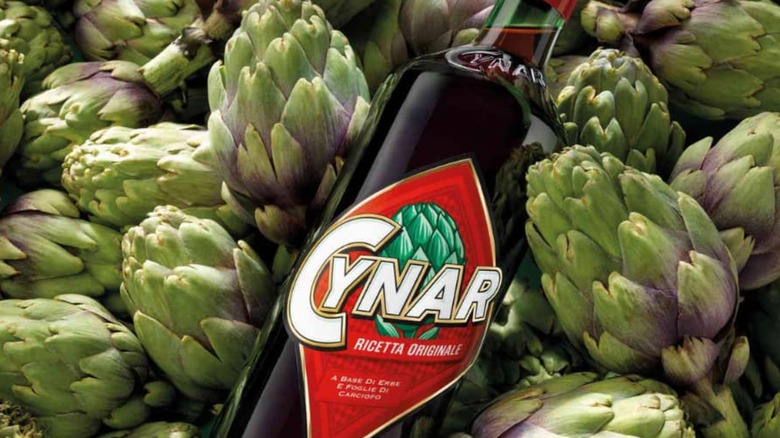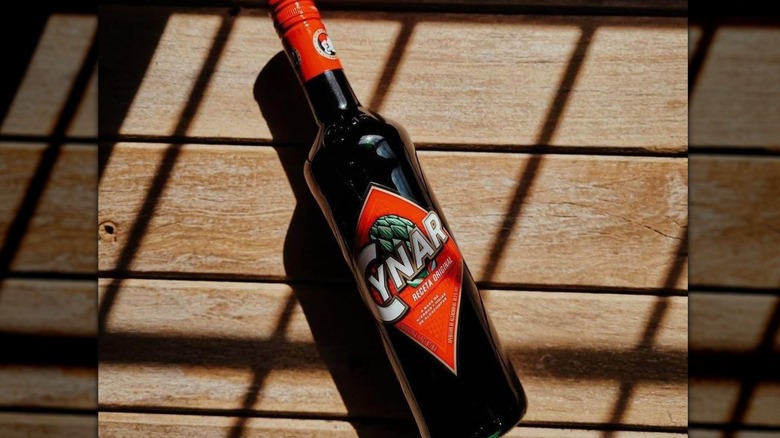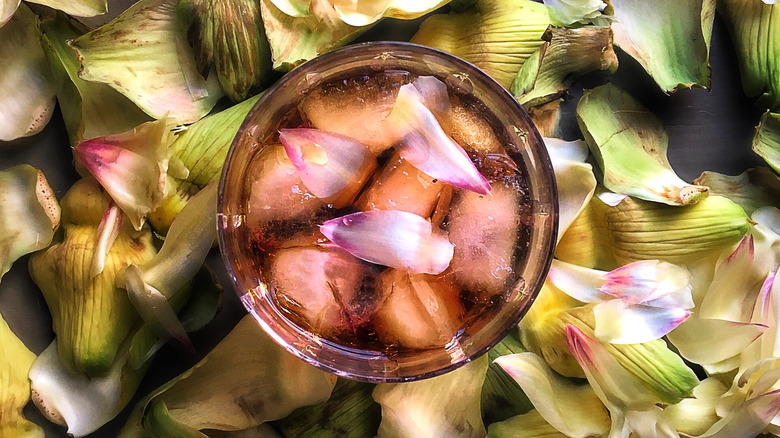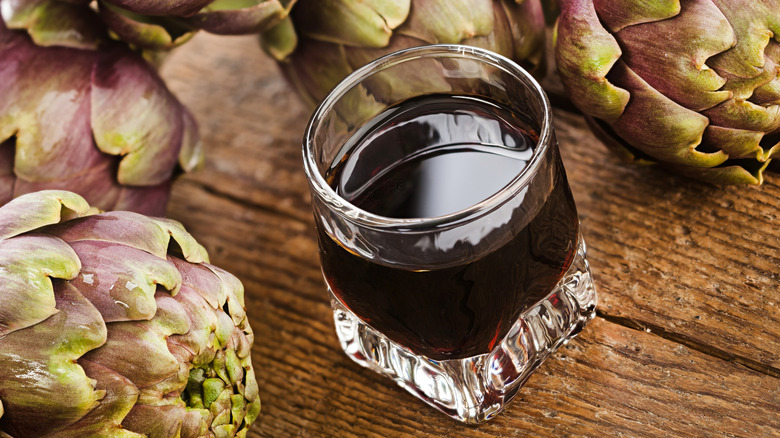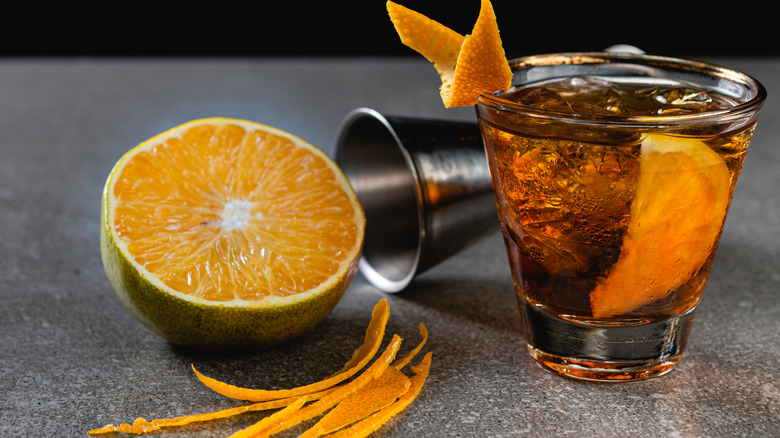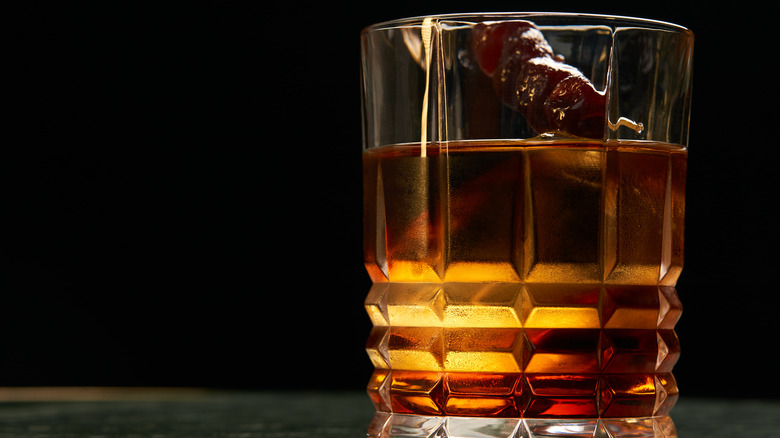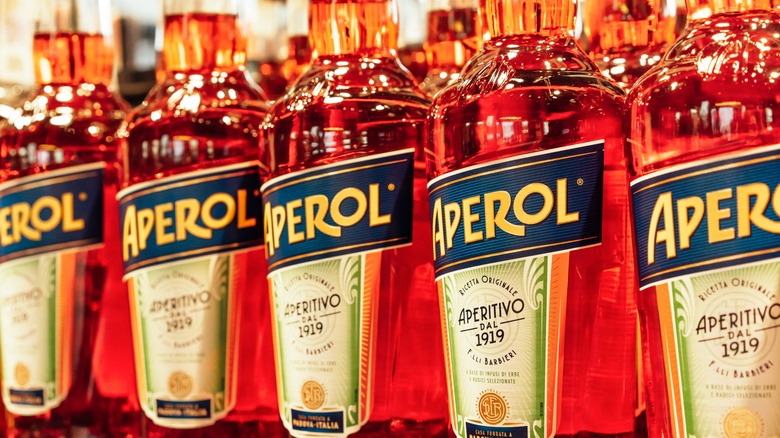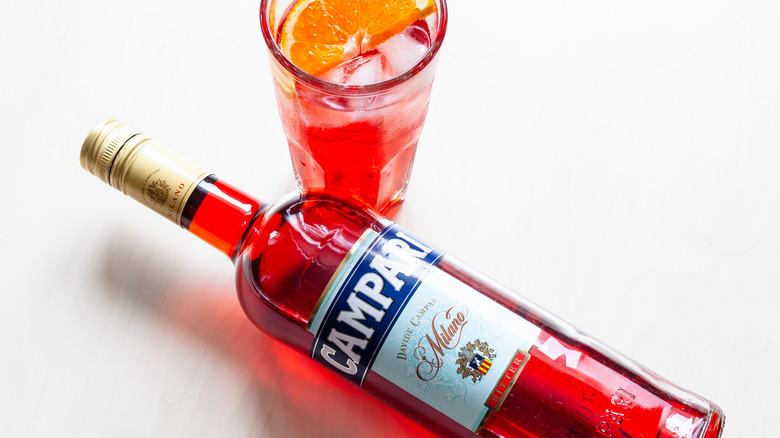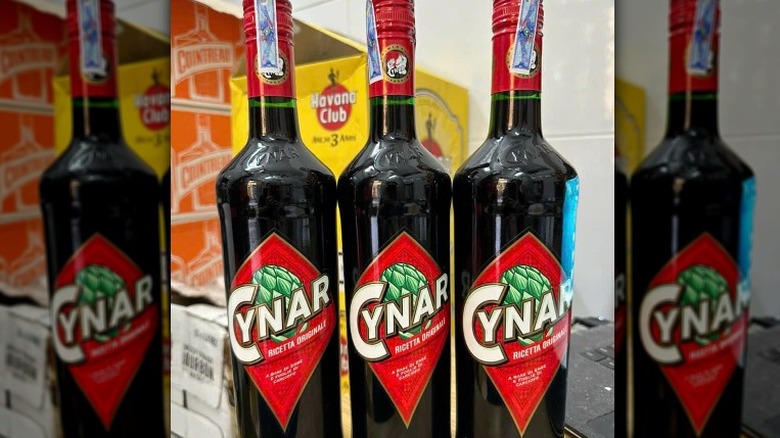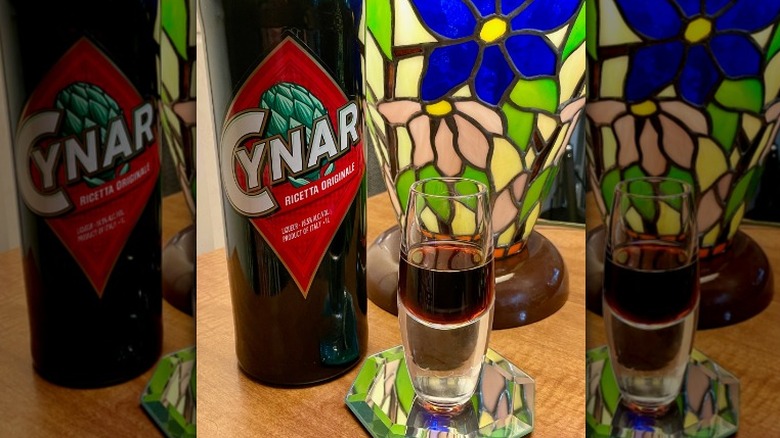What Is Cynar And What Does It Taste Like?
Fancy an after-dinner drink but don't know what to choose? Try a rich, complex, and bittersweet amaro. You may have already been familiar with this family of Italian bitters, often very dark in color and herbal, almost medicinal in flavor. But one that may not always land on the tip of your tongue (not just because of the confusion surrounding its pronunciation) is the one named after the prickly artichoke, a main ingredient in this bitter liqueur.
Cynar (pronounced chee-nahr) sits among the lesser-known amari but can hold its own among other well-known amari. It may not be as old and storied as brands like Averna, Braulio, or Fernet Branca or as eye-catching and colorful as Aperol or Campari, but its complex flavor profile and versatility make up for anything it may lack in age or looks. It holds a special place on many bartenders' shelves, which is reason enough to start drinking and using this amaro more often.
What is Cynar?
To understand Cynar, you need to know some more about the world of Italian bitters or what Italians refer to as amaro/amari. Cynar is just one of many hundreds of Italian bitters, among which you will find such recognizable names as Aperol, Campari, and Fernet Branca. So, what is amari exactly? Italian bitters are infused liquids made from a combination of herbs, roots, tree bark, spices, flowers, and citrus peels. Cynar is an infusion specifically made from 13 ingredients, including artichokes (Cynar scolymus), from which the name was derived. The liqueur is in a subfamily of Italian bitters referred to as carciofi (artichoke bitters), which have been around since Roman times.
Many amari were first created in monasteries and pharmacies and later marketed as health tonics to appeal to those looking for medicinal healing, specifically of the gut. To this day, Italian bitters are still believed to help stimulate the appetite, soothe an upset stomach, and aid in digestion. Thus, they're considered either an aperitif (pre-meal drink) or a digestif (post-meal drink). Usually, what differentiates the two is that aperitivi have a lower alcohol content, whereas digestivi have a higher alcohol content. The great thing about Cynar is that it's considered both an aperitivo and a digestive, unlike other amari, which often make it into one category or the other but not both. A stronger version, called Cynar 70, has an ABV of 35% and can function as a base spirit of similar flavor but more bravado.
Cynar history
Unlike many amari brands, a category that has existed since the 19th century, Cynar was only invented in 1952. Venetian philanthropist Angelo Dalle Molle and his brothers Angelo and Mario devised the concoction in Padua, Italy. In 1995, the Cynar brand was purchased by the Campari group, which also owns other famous amari brands such as Aperol, Averna, Braulio, and, of course, Campari.
Under Campari's leadership, Cynar had a renaissance starting in the early 2000s. Bartenders had a newfound interest in the liqueur due to its versatility. Soon new cocktails featuring Cynar were invented. And some began to swap other amari with Cynar in classic cocktails like the Negroni and the spritz. With this popularity in mind, the Campari group launched Cynar 70. This 70-proof (or 35% ABV) version of Cynar is based on the same original recipe with the same characteristic flavor but a higher alcohol content.
What does Cynar taste like?
Cynar doesn't taste like artichokes, even though its main ingredient is artichokes, and its label features an illustration of the vegetable. What you taste is its secret combination of 13 herbal ingredients. It's more or less a harmony of its ingredients without any single one carrying the high note. Like other amari, Cynar does have a bitter taste, but it's also pleasantly saccharine, making it a well-balanced amari. Expect it to coat your tongue and hit those sweet and bitter areas uniformly. It's also more subtle than many other amari, so you won't find it harsh. Still, characteristic of most amari, its flavor can be best described as vegetal or medicinal.
Its aroma also brings up notes of childhood cough medicine, but maybe there's something nostalgic in that, better yet, when combined with alcohol. Despite a thicker consistency and spiced flavor, Cynar is less forward than many other amari. With a 16.5% ABV, it is actually milder, so don't expect a kick. This low-alcohol content and its bittersweet flavor make Cynar a favorite aperitivo/digestivo among many amari lovers.
How to serve Cynar
Cynar works well either as an aperitivo, enjoyed before a meal to stimulate one's appetite, or as a digestivo, used to soothe one's tummy after a heavy meal. It's traditionally consumed neat or on the rocks, sometimes served with an orange or lemon slice. For something simple, Cynar can be added to soda or tonic water for a spritz-like drink and even to Coca-Cola. It can also be added to orange or grapefruit juice for a swirl of woodsy, tart fruit. Cynar-dominant cocktails are also quite popular, but an interesting use is as a support ingredient in place of vermouth or Angostura bitters. It makes a bold base ingredient for building layered drinks.
When served neat, it is traditionally at room temperature, but if you like, you can refrigerate it or serve it with ice. A typical serving of Cynar is 2 to 4 ounces. If you'd like a unique experience, freeze your Cynar 70. The high ABV will turn the liqueur's texture silky in the freezer. Then, serve it in chilled shot glasses for a refreshing post-dinner experience!
Cocktails to make with Cynar
Over the years, bartenders haven't held back when it came to being creative with Cynar, this unique bitter liqueur. There's a good reason why: Italian bitters and other bitters, in general, add a lot of complexity to drinks, so don't skip on using bitters in your cocktails.
Cynar can replace other amari in many cocktails to create entirely new drinks. As a standard, there is the Cynar Negroni, where Cynar replaces Campari to give you a smoother, rounder drinking experience. Simply combine the liqueur with gin and sweet vermouth. Similarly, replacing Campari with Cynar in a Boulevardier creates the Popinjay, great for someone who loves the complex flavors of Cognac. Take a Manhattan, swap Angostura with Cynar, and get the Little Italy,a bittersweet cocktail sweetened with Luxardo cherry of Italian character.
Then there are those cocktails that were invented completely with Cynar in mind. There's the Bitter Giuseppe, which should appeal to many for the name alone! It combines Cynar with vermouth, lemon juice, and Angostura bitters. It's a nice low-alcohol aperitivo that's perfect before dinner. If you want to try something unique, there's the Cynar Flip. It combines the artichoke bitters with simple syrup and an entire egg, shaken to create a rich and bittersweet, golden brown concoction. Refreshing and perfect for summer, the Poolside in Italy is a sparkling Cynar cocktail that features rum, grapefruit juice, and seltzer. The bitterness of the Cynar and grapefruit complement each other in this tropical cocktail.
Cynar vs. Aperol
Cynar and Aperol may both be Italian bitter liqueurs, but they have distinct flavor profiles and uses. You might say that Cynar tastes the way it looks. Made from artichoke leaves and a blend of herbs and plants, the dark brown liquid has a thicker consistency than Aperol and a richer, loamy taste comparatively. They share hints of bitterness, but the flavors of Cynar could be considered more grounding. Aperol, on the other hand, is known for its bright orange color and lighter, sweeter taste. It has a pronounced orange flavor in combination with its herbal and bitter notes and is more likely to be used in refreshing applications.
Although Cynar actually has less alcohol by volume (ABV) compared to many amaro styles, Aperol isn't one of them. The "Italian orange aperitivo," as Aperol is known, has only 11% ABV. Cynar is over four points higher. Although both bitters will taste great when combined with bubbly water, they're not an entirely clean swap in every instance. It's best to consider the character of the drink you want to make. Crave something a little more brooding? Cynar can give your beverages a similar bushy bite as Aperol, but it's less cloying and will deepen the profile. Both amari are also sold in different size bottles (750 milliliters for Aperol, 1 liter for Cynar), where Cynar can be as much as $10 more than Aperol.
Cynar vs. Campari
As stout Italian liqueurs with big personalities go, Campari is at the top. The emblematic aperitivo is as well known for its evocative red color as it is for its puckering taste, which is delivered at nearly a quarter of alcohol by volume (24%, to be specific). All that is to say, it's bolder than the Cynar. Not only is the artichoke amaro softer than Campari in total alcohol content, but it's got a lighter profile despite the caramel coloring. There were 100+ years between the birth of either amaro and a lot of room for new tastes to grow during that time. With such unique profiles, both deserve a spot at your bar. Still, the two are not completely dissimilar.
Cynar can be swapped for Campari in nearly any bartending circumstance since both ingredients are typically used to make a cocktail punch toward the earth. When making the substitution, prepare for your previously-Campari-based drinks to lose a bit of bitter edge in favor of something more rounded and with a spiced, garden-forward flavor. Campari has a slight edge of citrus, which isn't as prominent in Cynar. Both amari can be enjoyed entirely by themselves as well. A serving size of Campari is typically 2 ounces per drink, and Cynar is the same. Additionally, Cynar bottles are often sold in larger portions than Campari.
Where to buy Cynar
Fortunately, Cynar is widely available across the country. We can't promise that it will be found in every liquor store, but if your favorite shop has a reasonably large selection of mixers, bitters, and liqueurs, there's a pretty big chance they will carry it there. Cynar is sold in 1-liter bottles, which are larger than the standard packing for Campari, Aperol, or other amari. The larger size is a good thing, as a typical bottle of Cynar goes for anywhere between $35 to $40 — not exactly a price range that screams, "Make Cynar a weekly habit."
If your local liquor store doesn't carry Cynar, fear not. Bottles of Cynar are available for purchase from beverage delivery sites such as Total Wine, Drizzly, and even Instacart (location-dependent). These sites also offer Cynar 70, the ginger-leading form of amaro, which sits at higher proof of 35% ABV. This variation can cost in the base range of $40 to $50 per 1-liter bottle.
How to store Cynar
Knowing how to store your mixers and bitters is an important part of bartending at home or in a professional establishment. Who wants to waste such a hard-earned pleasure? Typically, the rule of thumb for these sorts of beverages is that if the beverage is a low-ABV liquid or made from a wine or cream base, then it should be refrigerated. This included fortified wines like port or vermouth. However, certain amari, like Cynar and Campari, don't require refrigeration and can actually degrade when exposed to extreme temperatures (hot or low).
Instead, make sure to store your Cynar in a cool, dry place with a stable temperature. If you have the tool available, it's recommended that you vacuum-seal your bottle to best preserve the flavors. Amaro that is not made from wine can last from six months to a year; however, the flavor begins to degrade around three months.
